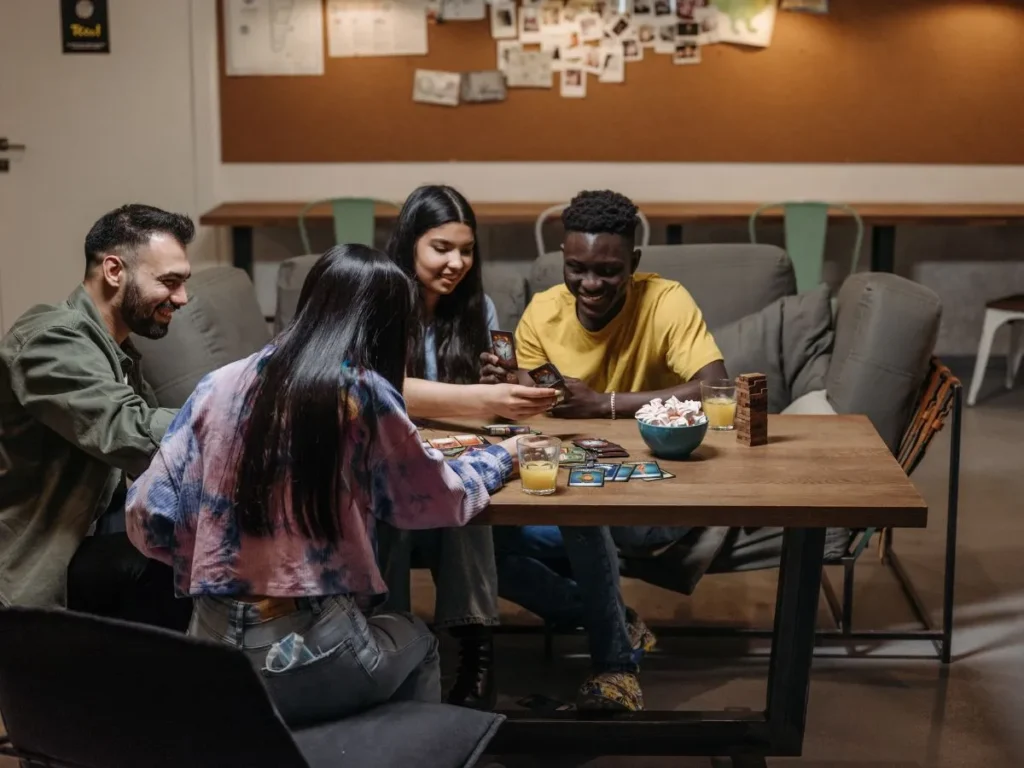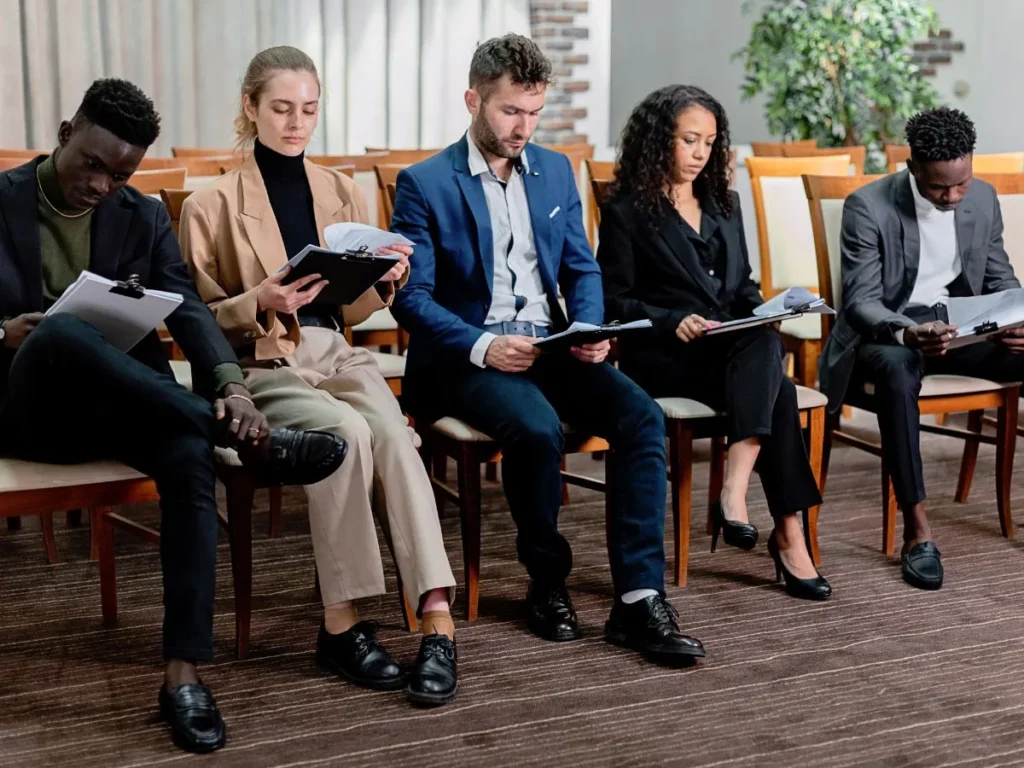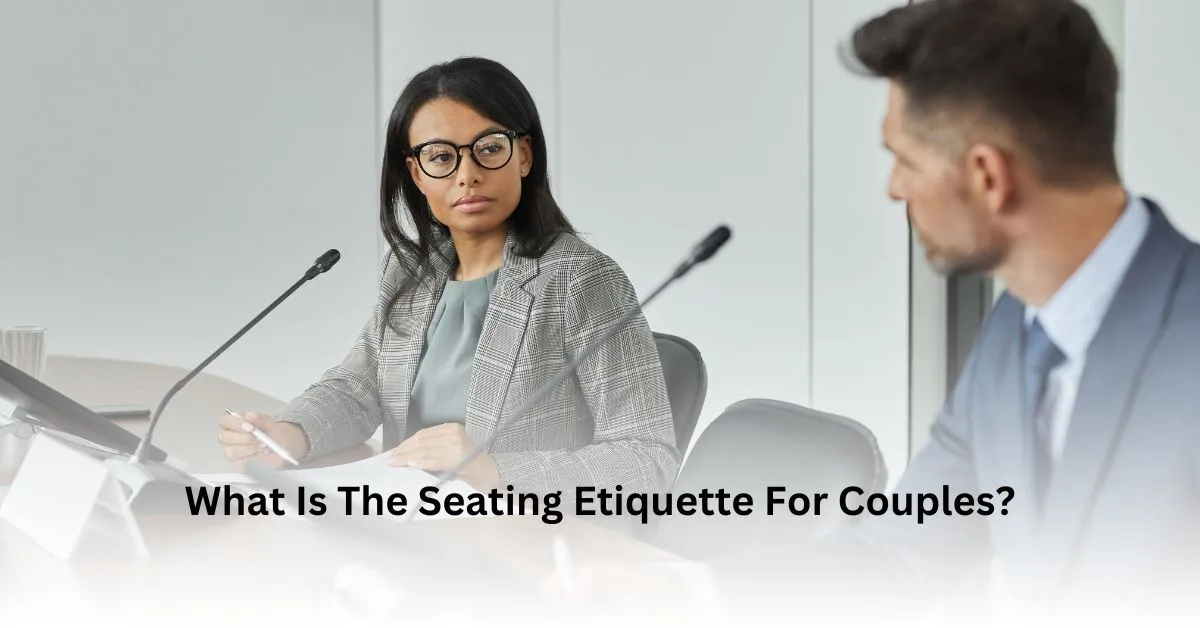Seating etiquette for couples is critical in defining the dynamics of social interactions, especially in situations with shared spaces and public events. From small meals to formal parties, how couples choose seating arrangements may have a big influence on the ambiance and perception of the event. Consider a candlelit dinner where each couple’s seating arrangement represents not just their marital dynamics but also their commitment to society’s norms of decorum and respect.
Why Seating Etiquette Matters for Couples?
The significance of seating etiquette for couples extends far beyond mere decorum; it serves as a tangible expression of mutual regard and consideration within the relationship. By adhering to established norms of seating protocol, couples demonstrate their commitment to each other’s comfort and well-being. Whether consciously or unconsciously, the seating arrangements chosen can convey messages of equality, partnership, or even hierarchy, shaping the perception of the couple’s dynamic by others present.
In this comprehensive exploration of seating etiquette for couples, we will delve into the historical origins, practical applications, and modern adaptations of this subtle yet essential aspect of social interaction. We will unravel the traditional rules that have governed seating arrangements for centuries, examining their evolution in response to changing societal norms and relationship dynamics. From formal dining occasions to casual gatherings, we will provide possible tips and insights to guide couples in navigating various scenarios with grace and confidence.
Additionally, we will challenge conventional norms and explore alternative approaches to seating that prioritize individual preferences and equality within relationships. Throughout the article, we will address common concerns and misconceptions surrounding seating etiquette, empowering couples to navigate social settings with poise and consideration. So, whether you’re planning a romantic date night or attending a formal event with your partner, join us as we embark on a journey to master the art of seating etiquette for couples.

Historical Origins of Seating Etiquette
To truly understand the nuances of seating etiquette for couples, it’s essential to explore its historical origins. Seating arrangements have long been intertwined with notions of hierarchy, status, and social order. In ancient civilizations such as Rome and Greece, seating positions were carefully orchestrated to reflect one’s rank and importance within society. This hierarchical seating system laid the foundation for the elaborate protocols that would come to define formal gatherings in later centuries.
Traditional Rules for Seating Couples
- Seating Arrangements Based on Gender
In traditional settings, seating etiquette for couples often adhered to strict gender-based norms. Men and women were typically seated separately, with men occupying positions of honor closer to the host or at the head of the table. This arrangement was rooted in notions of chivalry and the perceived need to protect and provide for women. While this practice may seem antiquated by modern standards, it persisted for centuries and influenced the social dynamics of formal gatherings.
- Traditional Etiquette in Formal Settings
Intricate rules of seating etiquette governed formal events such as banquets, galas, and diplomatic receptions. Couples were often expected to adhere to prescribed seating arrangements determined by factors such as rank, title, and familial connections. The hierarchical nature of these arrangements meant that couples were rarely seated side by side, as individual status took precedence over personal relationships. This adherence to tradition was seen as a mark of respect for the host and acknowledgment of social hierarchies.
- Evolving Trends in Modern Times
In recent decades, traditional seating etiquette for couples has undergone significant evolution, reflecting changing societal attitudes toward gender roles and relationships. While formal events may still adhere to certain protocols, there is greater flexibility and inclusivity in seating arrangements. Couples are now more likely to be seated together regardless of gender, with emphasis placed on companionship and mutual enjoyment rather than adherence to strict social hierarchies. Additionally, modern couples have greater agency in expressing their preferences and may opt for alternative seating arrangements that prioritize intimacy and connection over tradition.

As we navigate the complexities of seating etiquette for couples in modern times, It’s important to understand how these behaviors have been shaped by history. While traditional rules may still hold sway in certain settings, there is a growing acknowledgment of the need for flexibility and inclusivity in seating arrangements. By understanding the origins of seating etiquette and embracing evolving trends, couples can navigate social gatherings with grace and consideration for each other’s comfort and well-being.
Factors Influencing Seating Choices for Couples
Relationship Dynamics
The dynamics of their relationship deeply influence seating etiquette for couples. Whether they are newly dating or have been together for years, the stage of their partnership can dictate how they approach seating arrangements.
- New Couples vs. Established Relationships
For new couples, seating etiquette can be a delicate dance of navigating each other’s preferences and comfort levels. There may be a desire to sit close and engage in intimate conversation, yet also a hesitation to appear too forward or presumptuous. As they navigate these early stages of their relationship, new couples may opt for seating arrangements that strike a balance between proximity and respect for personal space.
In contrast, established relationships often have well-established patterns and routines when it comes to seating etiquette. Couples who have been together for years may have developed their own unspoken rules and traditions regarding where they prefer to sit in various settings. This familiarity and mutual understanding can make seating choices more intuitive and effortless, as couples instinctively know how to accommodate each other’s preferences.
- Considerations for Married Couples
Married couples face unique considerations when it comes to seating etiquette, particularly in formal settings or events with assigned seating. While some may prefer to be seated together as a symbol of unity and partnership, others may appreciate the opportunity to socialize independently and engage with different guests. Additionally, factors such as children, elderly relatives, or special dietary needs may influence seating choices for married couples as they prioritize the comfort and well-being of their entire family unit.

Social Context
The social context in which couples find themselves also plays a significant role in determining seating choices. Whether attending a formal event or a casual gathering with friends, couples must consider the expectations and norms of the occasion.
- Formal Events vs. Casual Gatherings
Formal events such as weddings, galas, or corporate dinners often come with prescribed seating arrangements and protocols. Couples may find themselves seated according to hierarchical considerations or assigned tables based on relationships with the host or other guests. In these settings, seating etiquette for couples may involve adhering to traditional norms of decorum and respect, even if it means temporarily parting ways to accommodate seating assignments.
On the other hand, casual gatherings with friends or family offer more flexibility in seating arrangements. Couples may have the freedom to choose where they sit based on personal preferences or social dynamics. Whether it’s squeezing onto a crowded couch at a house party or snagging a cozy corner booth at a casual restaurant, seating choices in informal settings are often guided by a desire for comfort and camaraderie.
- Cultural Influences on Seating Choices
Cultural influences can also shape seating etiquette for couples, as different societies may have varying norms and expectations regarding social interactions and hierarchies. In some cultures, seating arrangements may be highly structured, with strict rules governing who sits where based on factors such as age, gender, or social status. In others, there may be more emphasis on egalitarianism and inclusivity, allowing couples greater flexibility in choosing where to sit.
Ultimately, seating etiquette for couples is a nuanced interplay of relationship dynamics, social context, and cultural influences. Whether navigating the early stages of a new romance or settling into the comfortable routines of a long-term partnership, couples must navigate these factors with sensitivity and consideration for each other’s preferences. By understanding the various influences at play, couples can approach seating choices with confidence and grace, ensuring that every social gathering is a harmonious and enjoyable experience.

Practical Tips for Seating Couples
Communication is Key: Discussing Preferences in Advance
When it comes to seating etiquette for couples, communication is paramount. Before attending any social event or dining occasion, take the time to discuss seating preferences with your partner. Share your thoughts on where you’d feel most comfortable sitting and any concerns you may have. By openly communicating your preferences in advance, you can ensure that both you and your partner are on the same page and avoid any potential misunderstandings or discomfort during the event.
Navigating Different Scenarios
Formal dining events often come with assigned seating, which can pose challenges for couples who wish to sit together. In such scenarios, it’s essential to gracefully abide by the seating arrangements determined by the host or event organizers. However, if seating preferences are not explicitly assigned, consider arriving early to secure a desirable spot or politely inquire about the possibility of sitting together as a couple. Remember to approach the situation with tact and diplomacy, respecting the host’s discretion while advocating for your preferences.
- Formal Dining Events
Formal dining events often come with assigned seating, which can pose challenges for couples who wish to sit together. In such scenarios, it’s essential to gracefully abide by the seating arrangements determined by the host or event organizers. However, if seating preferences are not explicitly assigned, consider arriving early to secure a desirable spot or politely inquire about the possibility of sitting together as a couple. Remember to approach the situation with tact and diplomacy, respecting the host’s discretion while advocating for your preferences.
- Casual Settings
Casual settings, such as restaurants or informal gatherings, allow for greater flexibility in seating configurations for couples. Take advantage of this freedom by choosing seats that allow for easy conversation and interaction with your partner. Whether it’s a cozy corner booth or a shared spot at a communal table, prioritize comfort and intimacy while considering factors such as noise level and proximity to other guests.

- Group Dinners with Friends or Family
Group dinners with friends or family can present unique challenges for seating couples, especially if the group is large or diverse. In such situations, it is critical to create a balance between spending time with your partner and interacting with the other visitors. Consider seating arrangements that allow for alternating between sitting together and socializing with the larger group. This may involve strategically positioning yourselves near each other while also making an effort to interact with different individuals throughout the meal.
Handling Unforeseen Situations Gracefully
- Arriving Late or Separately
Sometimes, unforeseen circumstances may result in couples arriving late to a social event or dining occasion. If you find yourselves arriving separately, communicate with your partner to coordinate seating arrangements upon arrival. Be flexible and understanding, recognizing that seating options may be limited depending on the venue and event logistics. When joining the rest of the party, approach the situation with grace and apologize for any inconvenience caused by your delayed arrival.
- Seating Arrangements in Crowded Spaces
In crowded spaces where seating is limited, couples may need to adapt and be resourceful in finding suitable spots to sit together. Look for opportunities to join existing groups or share tables with other guests, being mindful of personal space and comfort levels. If seating is scarce, consider standing or mingling while keeping an eye out for available seats that can accommodate you and your partner. Remember to approach the situation with patience and consideration for others, prioritizing harmony and inclusivity in seating arrangements.
Modern Approaches to Seating Etiquette for Couples
A. Equality and Flexibility in Seating Arrangements
In recent years, there has been a notable shift towards embracing equality and flexibility in seating arrangements for couples. Gone are the rigid gender-based norms that once dictated where couples should sit; instead, there is a growing recognition of the importance of treating partners as equals in all aspects of social interaction. This egalitarian approach to seating etiquette acknowledges that both individuals in a couple should have an equal say in where they sit and how they engage with others in social settings.
B. Breaking Traditional Norms: Alternative Seating Options
One of the hallmarks of modern seating etiquette for couples is the willingness to break free from traditional norms and explore alternative seating options. Rather than adhering strictly to hierarchical seating arrangements or societal expectations, couples are encouraged to think outside the box and create seating configurations that reflect their unique preferences and dynamics. This may involve choosing unconventional seating arrangements, such as sitting side by side rather than across from each other or opting for communal seating where they can interact more freely with others.

C. Embracing Individual Preferences
In the modern era, seating etiquette for couples places a strong emphasis on embracing individual preferences and accommodating the needs and desires of each partner. Whether it’s choosing seats based on personal comfort, dietary restrictions, or social preferences, couples are encouraged to prioritize what works best for them as individuals and as a couple. This may mean opting for a quieter corner of the restaurant to facilitate intimate conversation or selecting seats with a better view of the event venue to enhance the overall experience.
By embracing equality, flexibility, and individual preferences in seating arrangements, couples can navigate social settings with confidence and authenticity. Whether attending formal events, casual gatherings, or intimate dinners for two, modern seating etiquette allows couples to express themselves freely and create meaningful connections with others. Ultimately, seating etiquette for couples is not about conforming to outdated norms or societal expectations but rather about honoring the unique dynamics and preferences of each partnership. As couples continue to evolve and redefine what it means to be in a relationship, so too will the ways in which they approach seating etiquette, embracing modern approaches that prioritize equality, flexibility, and authenticity above all else.
Debunking Myths About Seating Etiquette for Couples
Seating etiquette for couples is often shrouded in myths and misconceptions that can lead to confusion and unnecessary stress. One common myth is that there is a one-size-fits-all approach to seating arrangements, with strict rules dictating where couples should sit based on factors such as gender or relationship status. In reality, seating etiquette is far more nuanced and adaptable, with couples encouraged to prioritize their comfort and preferences when choosing where to sit. By debunking these myths, couples can feel empowered to approach seating arrangements with confidence and flexibility, knowing that there is no one “correct” way to navigate social settings.
Overcoming Resistance to Traditional Norms
In some social circles, there may be resistance to deviating from traditional norms of seating etiquette for couples. This resistance can stem from a desire to uphold perceived notions of decorum and respect or simply a reluctance to embrace change. However, couples need to remember that traditions are not set in stone and should be open to reinterpretation and evolution over time. By gently challenging traditional norms and advocating for more inclusive and flexible seating arrangements, couples can help pave the way for acceptance and understanding among their peers.

Navigating Cultural Differences
Cultural differences can also play an important role in shaping seating etiquette for couples, with varying norms and expectations across different societies and regions. What may be considered appropriate seating behavior in one culture could be viewed as disrespectful or inappropriate in another. For example, in some cultures, couples may be expected to sit separately or adhere to strict gender-based seating arrangements. In contrast, in others, there may be more emphasis on egalitarianism and inclusivity. Navigating these cultural differences requires sensitivity, open-mindedness, and a willingness to learn and adapt to the customs and traditions of others.
By addressing common concerns and misconceptions surrounding seating etiquette for couples, individuals can approach social settings with greater confidence and understanding. Whether debunking myths, overcoming resistance to traditional norms, or navigating cultural differences, couples can ensure that their seating arrangements reflect their values, preferences, and beliefs. Ultimately, seating etiquette is not about rigid adherence to outdated rules but rather about fostering mutual respect, consideration, and inclusivity in all social interactions. By embracing these principles, couples can create meaningful connections with others and enjoy enriching experiences in a wide range of social settings.
FAQ’s
Why is seating etiquette important for couples?
Seating etiquette is important for couples as it reflects their mutual respect and consideration for each other, influences perceptions of their relationship dynamics, and enhances their overall dining or event experience.
How should couples handle seating arrangements at formal events?
Couples should follow assigned seating arrangements if provided or strategically position themselves to sit together while respecting the overall seating plan. They should approach seating at formal events with grace, diplomacy, and respect for the host’s preferences and other guests’ comfort.
What should couples do if they have conflicting seating preferences?
Couples should openly discuss their preferences, aiming to find a compromise that satisfies both parties. Prioritizing mutual understanding and flexibility can help them navigate conflicting preferences with grace and respect.
How can couples handle unexpected changes in seating arrangements?
Couples should remain flexible and communicate with each other to quickly assess the situation and find the best solution together. By staying calm and cooperative, they can navigate unexpected changes in seating arrangements with ease and grace.
Also Read: My Girlfriend Never Knows What She Wants To Eat
Conclusion
Seating etiquette for couples is not just about where you sit; it’s a reflection of the respect and consideration you have for each other. Whether you choose to adhere to traditional norms or embrace more modern approaches, what matters most is that your seating choices are made with thoughtfulness and mutual understanding.
As you navigate social settings with your partner, I encourage you to prioritize consideration and respect in your seating choices. By communicating openly, being flexible, and embracing individual preferences, you can ensure that your seating arrangements enhance rather than detract from your overall experience. So, whether you’re enjoying a romantic dinner for two or attending a social event with friends, remember that the way you choose to sit reflects the strength and harmony of your relationship.
